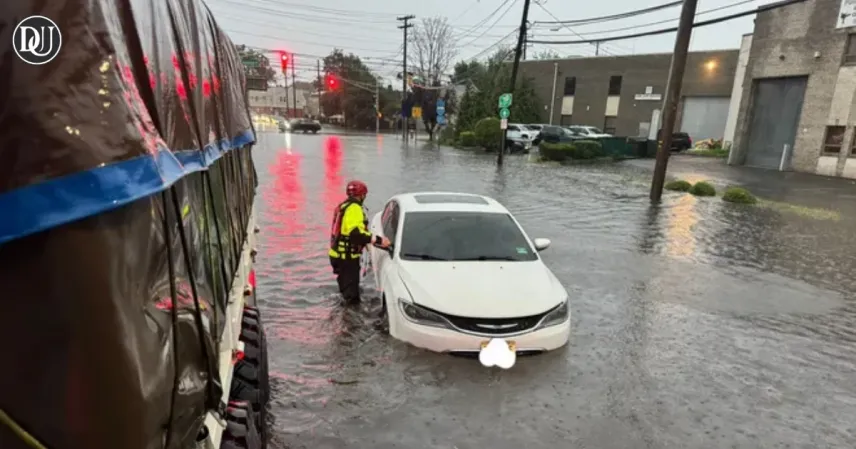Remember that huge flash flood warning issued across New York City recently? New Jersey basically declared a state of emergency right around then too, you know, because of those insane rains and storms just battering parts of the US. It's wild how quickly things can escalate, like one minute it's just heavy rain, and the next, roads are closed, basements are filling up, and people are evacuating. Honestly, it makes you wonder if this is just the new normal for our weather patterns, especially in this region.
It feels like every other month now, there's some kind of extreme weather event happening, and New Jersey, with its low-lying areas and proximity to coastal regions, often seems to get hit particularly hard. You see the pictures, right? Cars practically submerged, people kayaking down what used to be main streets – it's pretty surreal. And it's not just the immediate chaos; there's always that lingering aftermath of property damage, displacement, and just the sheer hassle of cleaning up.
🌧️ When the Rain Just Doesn't Quit
The sheer volume of water coming down has been, well, just relentless at times. You hear about flash flood warnings, and you think, "A lot of rain." But then you see videos of water rising inches per minute, completely overwhelming drainage systems that, let's be real, probably weren't built for this kind of consistent deluge anyway. It’s like the ground just can’t absorb it fast enough, and the rivers and streams can’t carry it away. I mean, how much can a storm drain actually handle before it just gives up? It’s a real question, isn't it?
It’s not just an inconvenience for commuters trying to get home or people out running errands; this is about homes, businesses, entire communities getting absolutely swamped. People lose their cars, their belongings, irreplaceable family photos – it’s a deeply personal disaster for so many. And then there's the long-term impact on things like mold growth, structural damage, all that stuff that costs a fortune to fix, if it can even be fixed.
🚨 State of Emergency: What That Even Means
When a state of emergency gets declared, like New Jersey did, it's not just a fancy phrase, you know? It basically gives officials more power to allocate resources quickly, coordinate emergency services, even enforce things like mandatory evacuations or curfews. It’s a big deal. The Times of India reported on it, confirming a state of emergency in New Jersey following these battering rains and storms. It means the situation is serious enough that normal procedures aren't cutting it, and they need to pull out all the stops.
It also opens the door for federal assistance, which, honestly, is often critically needed for these kinds of widespread natural disasters. Because who has the budget for this level of damage, locally? Not many places, I imagine. It's a sign that the local infrastructure and first responders are stretched thin, or are about to be, and they need that extra backing. It’s about protecting lives first and foremost, then property as much as possible.
🏠 Impact on Daily Life and Infrastructure
Think about it: schools close, public transport gets disrupted, businesses can't open. The ripple effect is massive. You can't just drive through flooded streets – it's incredibly dangerous, not to mention illegal if the road is closed. I’ve heard countless stories of people getting stuck, or worse, having their cars totally wrecked because they underestimated the water. It’s a constant reminder that even in developed areas, we’re still pretty vulnerable to nature’s fury.
Infrastructure takes a beating too. Roads get washed out, bridges become unstable, underground utilities can get damaged. Repairing all that isn't just about money; it’s about time, disruption, and the sheer effort involved in rebuilding. And then you have to consider the long-term wear and tear. If this happens repeatedly, what does that mean for the longevity of our roads, our sewers, our power grids? It’s not just a one-time fix, you know, it’s an ongoing battle.
🤔 Why So Much Flooding, Anyway?
This is the question that really sticks with you. Is it just bad luck, or something more? A lot of people, myself included, can’t help but connect these increasingly frequent and intense storms to climate change. The science seems to point to warmer oceans leading to more moisture in the atmosphere, which then translates into heavier rainfall events. Could be wrong, but it just feels like the pattern is pretty clear at this point, especially with the global warming trends we’re seeing.
Then there's also the aspect of urban development. More concrete, more asphalt, less permeable ground to soak up the water. When you pave over wetlands and natural flood plains, where does the water go? It has to go somewhere, and often, that somewhere ends up being our streets and homes. It’s a complex issue, honestly, probably a mix of both climate shifts and how we’ve built our communities. There’s no single easy answer, that’s for sure.
🛣️ Navigating the Chaos: Roads and Commutes
For anyone living or working in these affected areas, the daily commute becomes a nightmare. Roads you usually take are closed, detours are jammed, and even if you find a route, you’re just hoping you don’t hit an unexpected patch of deep water. It’s stressful, you know, adding hours to what should be a simple drive. And for emergency services, it’s even worse – trying to reach people when access is limited or impossible. Imagine being stuck on the highway for hours, just watching the water rise around you.
It highlights how reliant we are on predictable infrastructure. When that predictability is gone, everything slows down, or stops entirely. Businesses lose productivity, people miss work, appointments get cancelled. It’s not just an inconvenience; it can have significant economic repercussions for the entire region. People start to rethink where they live, where they work, what routes they take. It changes behavior, essentially.
🔮 Looking Ahead: Long-Term Outlook
What’s the long-term strategy for places like New Jersey? It can't just be about cleaning up after each storm. There has to be more proactive planning – investing in better drainage systems, perhaps considering more natural solutions like restoring wetlands or creating green infrastructure. You hear about these concepts, but actually implementing them on a large scale, across an entire state, must be incredibly challenging, and expensive.
But it feels necessary, doesn't it? Because if these extreme weather events are truly becoming more common, then the current approach of just reacting isn't sustainable. It's about resilience, basically. How do we build communities that can withstand these floods, bounce back faster, and protect their residents? It's a huge undertaking, for sure, but definitely one that needs to be taken seriously. I mean, we can't just keep letting our homes get swamped, can we? It’s an ongoing conversation, and honestly, a pretty critical one for the future of the state.
It just makes you think, you know, late at night, about all these bigger picture things happening right in our backyard. It's not some far-off problem; it’s literally affecting our neighbors, our roads, our daily lives. Kind of puts things into perspective, doesn't it? Just something that popped into my head.
Read more:-










